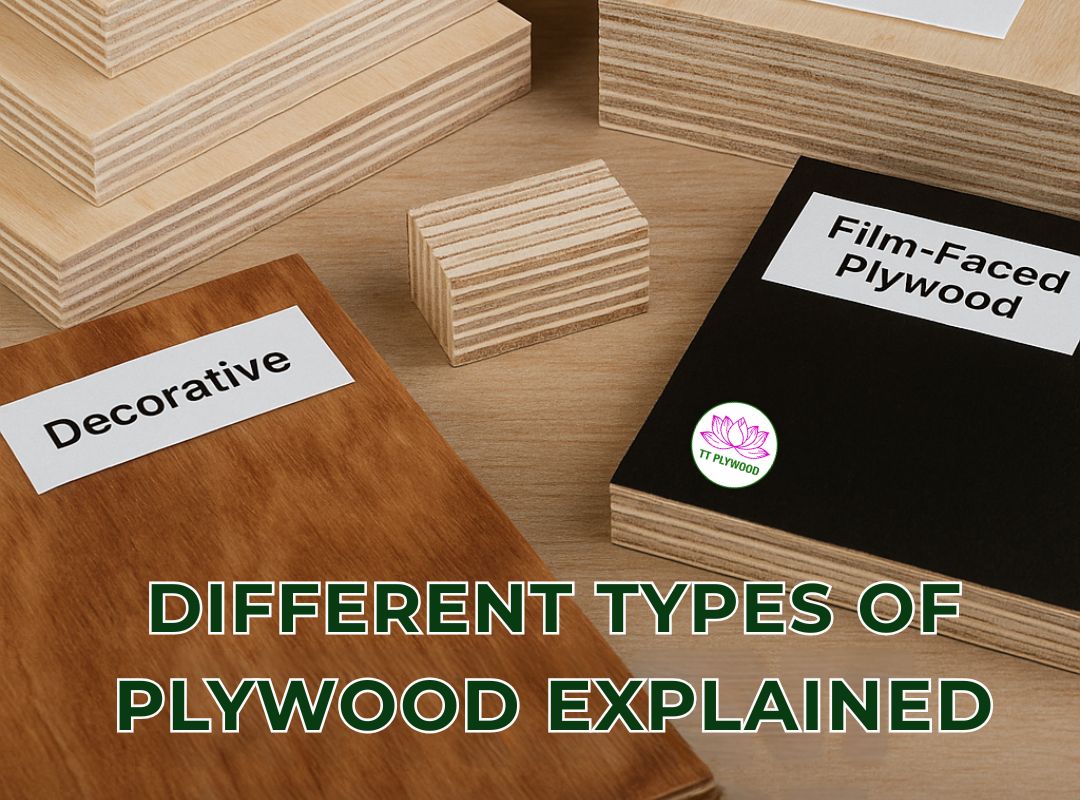-
-
-
Total payment:
-

Different Types of Plywood Explained: A Comprehensive Guide for Importers
Posted by Thanh Uyên at 03/09/2025
Why Importers Must Understand Plywood Types
Plywood is one of the most versatile engineered wood products in global trade. From furniture and cabinetry to formwork systems and shipping crates, plywood is a backbone material for industries across the United States, the European Union, and Asia. Yet one common challenge persists among buyers: distinguishing the different types of plywood and choosing the right one for each application.
For global importers and contractors, the implications go far beyond technical performance. Selecting the wrong panel type can result in higher costs, compliance issues, or client dissatisfaction. This guide provides a comprehensive overview of the major plywood categories used in international trade, tailored for businesses sourcing from Asia particularly Vietnam, which is emerging as a leading plywood hub.

Commercial Plywood: The Entry-Level Choice
Commercial plywood, often referred to as “MR-grade” (Moisture Resistant), is the most common and economical type. It is widely used for interior furniture, paneling, and partitions where exposure to moisture is limited.
For importers, commercial plywood offers a cost-effective entry point, especially for mass-market furniture or cabinetry production. However, it is not designed for structural or exterior use, and this limitation should be communicated clearly to downstream buyers.

Marine Plywood: Built for Durability
Marine plywood is manufactured with superior-grade veneers and bonded with phenolic WBP (Weather and Boil Proof) adhesive. It is designed to withstand prolonged exposure to water, making it the material of choice for shipbuilding, docks, and humid environments.
In global trade, marine plywood is often benchmarked against British Standard BS 1088. Importers serving coastal construction or boatbuilding industries in the EU and US must ensure suppliers provide authentic marine-grade panels, as mislabeling is a recurring issue in the marketplace.

(Marine Plywood)
Film-Faced Plywood: The Formwork Specialist
Film-faced plywood is a specific category within formwork plywood, coated with phenolic or melamine films to resist water and create smooth concrete surfaces. Contractors in infrastructure projects often prefer this type due to its high reuse cycle, sometimes up to 15–20 pours if handled correctly.
For importers, film-faced plywood represents a premium but cost-efficient option for the construction sector. Buyers should confirm edge sealing quality and film density, as these directly influence durability.

(Film-Faced Plywood - TT Plywood)
Decorative Plywood Panels: Adding Aesthetic Value
Decorative plywood refers to panels overlaid with veneers of high-value species such as oak, walnut, birch, or teak. These panels combine structural stability with the natural beauty of hardwood surfaces, making them ideal for high-end furniture and interior design.
Importers targeting European and North American furniture markets often use decorative plywood to position themselves in premium segments. Since aesthetics are critical, quality control on veneer grading and color uniformity is essential.
Structural Plywood: Engineered for Strength
Structural plywood is manufactured to meet specific engineering standards for load-bearing applications. It is commonly used in flooring, roofing, and wall bracing. The defining characteristic is compliance with standards such as EN 636 (Europe) or PS 1–19 (United States).
From a B2B standpoint, structural plywood is not just about strength but also about regulatory acceptance. Importers should prioritize suppliers who can provide certified test reports demonstrating compliance with these standards.
LVL (Laminated Veneer Lumber): Beyond Traditional Panels
Laminated Veneer Lumber, or LVL, is often grouped with plywood because it is also made from veneer sheets. However, unlike standard plywood panels, LVL veneers are aligned in the same direction, giving the material exceptional strength for beams, headers, and scaffold boards.
Importers sourcing for the construction industry increasingly view LVL as a substitute for solid timber, especially as global regulations tighten around deforestation and log exports. LVL’s engineered consistency reduces waste and improves structural reliability.

Hardwood vs Softwood Plywood
Another distinction importers must recognize is between hardwood plywood (using species such as birch, eucalyptus, or acacia) and softwood plywood (typically pine or spruce). Hardwood panels are denser and provide smoother finishes, whereas softwood panels are lighter and widely used in North American construction.
For global buyers, the choice often comes down to end-market requirements. US contractors may prioritize softwood plywood for framing, while EU furniture producers prefer hardwood plywood for durability and aesthetics.
The Business Implications for Importers
Understanding the different types of plywood is more than a technical exercise it directly affects profitability, compliance, and customer satisfaction.
- Importers who fail to distinguish between commercial and structural plywood risk compliance failures in regulated markets.
- Contractors who use non-marine panels in humid environments face early material failures and warranty claims.
- Furniture manufacturers who overlook decorative options may lose ground in premium market segments.
For B2B decision-makers, mapping product types to project requirements is not optional, it is central to building sustainable supply chains.
Market Outlook 2025–2026: Why Understanding Plywood Types Matters More Than Ever
The plywood trade is no longer just about buying panels at the lowest possible cost. In 2025, global buyers face two major shifts: regulatory compliance and supply chain diversification. In the EU, the Deforestation Regulation (EUDR) requires importers to prove the legality and sustainability of their plywood supply chains. In the US, contractors are increasingly pressed to deliver projects that meet green building standards while maintaining competitive pricing.
For importers, this means that knowing the different types of plywood is not simply a technical matter, it is a strategic one. Choosing between commercial, structural, or marine-grade panels can directly affect whether a shipment clears customs, whether a project qualifies for certification, and whether end customers view a supplier as trustworthy. Vietnam, with its growing export capacity and FSC-certified production base, is emerging as a preferred alternative to traditional suppliers from China or Russia. Importers who can connect the dots between panel types, compliance frameworks, and market trends will be in the strongest position to capture new opportunities in 2025 and beyond.
At TT Plywood, we specialize in supplying the full spectrum of plywood types: commercial, marine, film-faced, decorative, structural, and LVL. With FSC certification and EUDR-ready compliance, our panels meet the highest international standards for legality, sustainability, and performance.
Contact TT Plywood today for customized solutions, competitive pricing, and reliable exports to the EU, US, and beyond.
📞Hotline/WhatsApp/Line/Kakao: +84 32 694 2288
📧Email: info@ttplywood.com
🌐Website: https://ttplywood.com/
FAQ
Q1: What is the difference between commercial and marine plywood?
Commercial plywood is designed for dry interior use, while marine plywood is bonded with waterproof glue and suitable for prolonged water exposure.
Q2: How many times can film-faced plywood be reused?
High-quality film-faced plywood can be reused 15–20 times in formwork applications, depending on handling and project conditions.
Q3: Are decorative plywood panels only for luxury furniture?
Not exclusively. While decorative plywood is popular in premium furniture, it is also used in offices, retail spaces, and interiors where aesthetics are important.
Q4: Why do importers choose LVL over solid timber?
LVL offers consistent quality, engineered strength, and better compliance with forestry regulations compared to natural logs.
Q5: Which standards should importers check for structural plywood?
EN 636 in Europe and PS 1–19 in the United States are the key benchmarks for load-bearing plywood.
References
- American Plywood Association (APA) 2023. Plywood and Structural Panels: Standards and Applications. Tacoma, WA: APA.
- European Committee for Standardization (CEN) 2022. EN 636 Plywood Specifications for Structural Use. Brussels: CEN.










